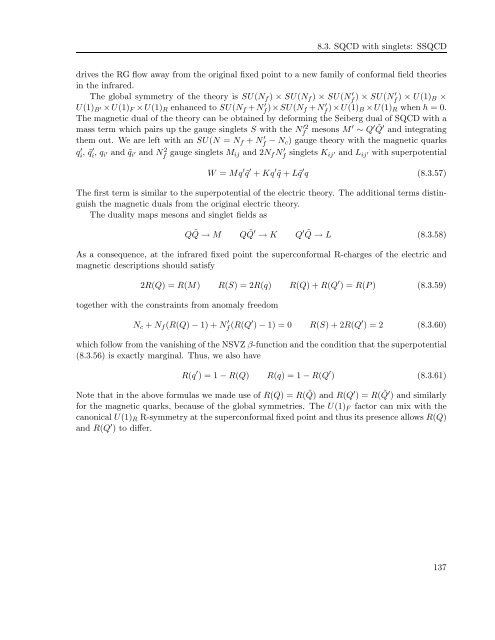Perturbative and non-perturbative infrared behavior of ...
Perturbative and non-perturbative infrared behavior of ...
Perturbative and non-perturbative infrared behavior of ...
Create successful ePaper yourself
Turn your PDF publications into a flip-book with our unique Google optimized e-Paper software.
8.3. SQCD with singlets: SSQCD<br />
drives the RG flow away from the original fixed point to a new family <strong>of</strong> conformal field theories<br />
in the <strong>infrared</strong>.<br />
The global symmetry <strong>of</strong> the theory is SU(Nf) × SU(Nf) × SU(N ′ f ) × SU(N ′ f ) × U(1)B ×<br />
U(1)B ′ ×U(1)F ×U(1)R enhanced to SU(Nf +N ′ f )×SU(Nf +N ′ f )×U(1)B ×U(1)R when h = 0.<br />
The magnetic dual <strong>of</strong> the theory can be obtained by deforming the Seiberg dual <strong>of</strong> SQCD with a<br />
mass term which pairs up the gauge singlets S with the N ′2<br />
f mesons M ′ ∼ Q ′ ˜ Q ′ <strong>and</strong> integrating<br />
them out. We are left with an SU(N = Nf + N ′ f − Nc) gauge theory with the magnetic quarks<br />
q ′ i , ˜q′ i , qi ′ <strong>and</strong> ˜qi ′ <strong>and</strong> N2 f gauge singlets Mij <strong>and</strong> 2NfN ′ f singlets Kij ′ <strong>and</strong> Lij ′ with superpotential<br />
W = Mq ′ ˜q ′ + Kq ′ ˜q + L˜q ′ q (8.3.57)<br />
The first term is similar to the superpotential <strong>of</strong> the electric theory. The additional terms distinguish<br />
the magnetic duals from the original electric theory.<br />
The duality maps mesons <strong>and</strong> singlet fields as<br />
Q ˜ Q → M Q ˜ Q ′ → K Q ′ ˜ Q → L (8.3.58)<br />
As a consequence, at the <strong>infrared</strong> fixed point the superconformal R-charges <strong>of</strong> the electric <strong>and</strong><br />
magnetic descriptions should satisfy<br />
2R(Q) = R(M) R(S) = 2R(q) R(Q) + R(Q ′ ) = R(P) (8.3.59)<br />
together with the constraints from anomaly freedom<br />
Nc + Nf(R(Q) − 1) + N ′ f (R(Q′ ) − 1) = 0 R(S) + 2R(Q ′ ) = 2 (8.3.60)<br />
which follow from the vanishing <strong>of</strong> the NSVZ β-function <strong>and</strong> the condition that the superpotential<br />
(8.3.56) is exactly marginal. Thus, we also have<br />
R(q ′ ) = 1 − R(Q) R(q) = 1 − R(Q ′ ) (8.3.61)<br />
Note that in the above formulas we made use <strong>of</strong> R(Q) = R( ˜ Q) <strong>and</strong> R(Q ′ ) = R( ˜ Q ′ ) <strong>and</strong> similarly<br />
for the magnetic quarks, because <strong>of</strong> the global symmetries. The U(1)F factor can mix with the<br />
ca<strong>non</strong>ical U(1)R R-symmetry at the superconformal fixed point <strong>and</strong> thus its presence allows R(Q)<br />
<strong>and</strong> R(Q ′ ) to differ.<br />
137
















